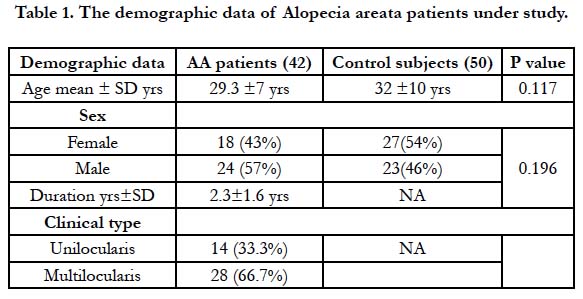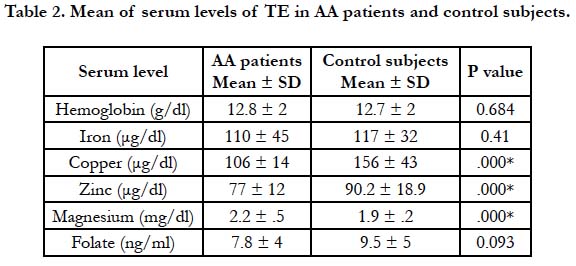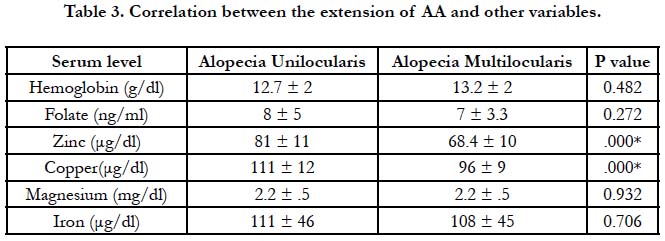Serum Trace Element Levels in Patients with Alopecia Areata
Nadia A. El Sherif1*, Salwa A. El-Dibany2
1 Dermatology Department, Benghazi university, Faculty of Medicine, Benghazi.
2 Dermatology Department, Omar El-Mukhtar University, Al-Beida, Libya.
*Corresponding Author
Nadia A. El Sherif,
Dermatology Department, Benghazi university, Faculty of Medicine, Benghazi, Libya.
Tel: 00218913760697
Fax: 00218162226270
E-mail: elsherifnadia@yahoo.com
Received: April 05, 2020; Accepted : June 26, 2020; Published: July 01, 2020
Citation: Nadia A. El Sherif, Salwa A. El-Dibany. Serum Trace Element Levels in Patients with Alopecia Areata. Int J Clin Dermatol Res. 2020;8(3):259-262. doi: dx.doi.org/10.19070/2332-2977-2000057
Copyright: Nadia A. El Sherif© 2020. This is an open-access article distributed under the terms of the Creative Commons Attribution License, which permits unrestricted use, distribution and reproduction in any medium, provided the original author and source are credited.
Abstract
Background: Alopecia areata is a disease characterized by focally, non-scarring hair loss on the scalp or any hair-bearing
surface. The etiology is unknown, although the evidence suggests that AA is an immunologically mediated disease. Trace elements
are essential cofactors for multiple enzymes and have a role in important functional activities within the hair follicle.
Objective: The aim of our study was to evaluate serum concentrations ofcopper (Cu), zinc (Zn), magnesium (Mg), iron (Fe),
folate and blood hemoglobin (Hb) in patients with AA and healthy subjects. We also examined a possible association between
serum levels of TE and the clinical types, durationand family history of AA.
Patients and Methods: The serum levels of TE were measured in 42 patients with AA and 50 age and sex matched healthy
controls. According to the clinical type of AA, patients were divided into 2 groups: patients with single patch of hair loss
(alopecia unilocularis, AU), or with multiple patches (alopecia multilocularis, AM).
Results: Serum levels of Cu and Zn were significantly lower in patients as compare to control subjects (P =.000), serum Mg
were significantly increased (P =.000). While Hb show no difference between patients and control subjects, serum Fe and
folate both were insignificantly decreased in patients with AA. Patients with AU had significantly lower serum Zn and Cu
(P=.000), whereas, serum Mg, Fe, folate and Hb show no significant difference (P>0.05) compare to patients with AM.No
correlations were found between gender, family history of AA, duration of the disease, and serum levels of TE.
Conclusion: Present study suggests that low serum levels of zinc and copper seem to be an important risk factors for AA.
2.Introduction
3.Objective of the Study
4.Patients and Methods
5.Results
6.Discussion
7.Conclusion
8.References
Keywords
Alopecia Areata; Trace Elements; Unilocularis; Multilocularis.
Introduction
Alopecia areata (AA) is an organ-specific autoimmune disorder
that targets anagen phase hair follicles. It has an unpredictable
chronic-relapsing course, leading to transient non-scarring hair
loss. Clinically, presentations vary considerably between individuals,
ranging from small patches of alopecia to the loss of all body
hair; alopecia universalis [1].
Prevalence of AA has been estimated to about 0.2% of the general
population. AA can start at any age, however in the majority of
patients, the onset is within the first three decades of life. There
is none race or sex predilection. AA is often associated with other
autoimmune diseases that must be investigated [1].
In most patients, disease severity is closely correlated with psychological distress, and management of AA should include
psychological support. The course of AAis not predictable, as
spontaneous remission is possible, as well as a chronic course not
responding to therapy [2].
Trace elements are essential cofactors for multiple enzymes and
have important functional activities within hair follicles [3]. They
perform various catalytic, structural and regulatory functions of
our body [4]. The trace elements such as zinc and copper have
much important role in the growth and development of hair [3].
There are many studies claim that imbalance of trace elements
may trigger AA [4].
Objective of the Study
To evaluate serum concentrations of copper (Cu), zinc (Zn), magnesium (Mg), iron (Fe), folate and blood hemoglobin (Hb) in patients
with AA and healthy subjects.
To examined a possible association between serum levels of TEwith
clinical types, duration and family history of AA.
Patients and Methods
The study included 42 patients with a diagnosis of patchy AArecruited
from the OPD of Dermatology Department at El-Jumhoria
hospital in Benghazi city, Libya. Patients with alopecia totals,
alopecia universalis, as well as patients with any autoimmune skin
or systemic diseases were excluded from the study. According to
the clinical type of AA, patients were divided into 2 groups: patients
with single patch of AA; alopecia Unilocularis (AU), and
patients with multiple patches; alopecia multilocularis (AM). According
to the duration of disease, the patients were divided into 2
groups: duration of 1 year or less, and more than 1 year. The control
group consisted of 50 sex and age matched healthy subjects.
Blood sample was taken from each patient and control subject
for measurement of serum levels of Zn, Cu, Mg, Fe, folate and
Hb. A signed consent was obtained from all patients and subjects
after explaining the nature of the study to them and manuscript is
according to declaration of Helsinki.
All statistical analyses were performed using SPSS software for
Windows (Version 16.0). Results are presented as mean ± standard
deviations for continuous variables and as a number (%) for
categorical variables. The Chi-square testand independent t-test
were used for statistical analysis. Differences were considered as
statistically significant with P values < 0.05.
Results
Table 1. Show the demographic data of patients under study and
control subjects. In the total of 42 patients with AA, there were
14 (33.3%) patients with AU, 28 (66.7%) patients with AM.
Serum levels of Cu and Zn were significantly lower in patients as compare to control subjects (P=.000), serum Mg were significantly increased (P=.000). While Hb show no difference between patients and control subjects, serum Fe and folate both were insignificantly decreased (P>0.05) in patients with AA (Table 2). According to clinical type patients with AM had significantly lower serum Zn and Cu (P=.000), as compare to AU patients. Whereas, serum Mg, Fe, folate and Hb show no significant difference (P>0.05) (Table 3). No correlations were found between gender, family history of AA and duration of the disease, and serum levels of TE.
Discussion
Alopecia areata is a common immune-mediated condition characterized
by non-scarring hair loss. Lifetime incidence of AA ranges
from 1.7%-2.1%, with higher prevalence in younger patients but
no significant difference in incidence exists between males and
females [5]. AA can have profound effects on patient's quality of
life [1].
Trace elements, which though required in only minute amounts,
have a physiological function as enzyme cofactors, biologic substrates,
and even as hormones [6]. Physical properties of the hair,
their shape, color, thickness, elasticity, growth rate depend on the
microelement composition [6]. Moreover, trace elements are essential
cofactors for multiple enzymes and have a role in important
functional activities within the hair follicle [7]. Furthermore,
some micro nutrients reduce oxidative stress, an increasingly suspected
contributor to AA pathogenesis [7].
Zn and Cu are an essential trace elements required for functional
activities in hair follicle and help in hair follicle recovery [6]. Many
studies speculated that a copper/zinc imbalance might play a role
in AA pathogenesis through an imbalance in oxidant/antioxidant
activity [8]. Zn and Cu required for the function of many enzymes
like; alkaline phosphatase which has elevated activity in hair follicle,
and copper/zinc superoxide dismutase which is potent antioxidant
[8]. Moreover, deficiency of Zn impairs DNA and RNA
production which is required for the normal division of hair follicle
cells and developmental stage of hair growth [9].
In the present study, mean serum Zn and Cu were significantly
lower in patients with AA than that of controls, Our results are
in agreement with previous studies which reported lower serum
levels of Zn and Cu in their patients with AA [4, 8-12].
Naginiene et al., reported a lower level of zinc in blood and urine
of children with alopecia and increased levels of copper and chromium
concentrations in their hair compared to healthy individuals
[13], however, other studies did not find any difference in serum
Zn and Cu levels of AA patients versus controls [3, 6, 7, 14].
In the present study patients with AM had significantly lower
serum Zn and Cu as compare to patients with AU, this was in
agreement with study of Abdel Fattah et al., who reported an
inverse correlation between serum zinc levels and severity of AA
[8]. No correlations were found between duration of the disease
and serum levels of Zn and Cu, inconsistent with previous study
which reported an inverse correlation between serum zinc levels
and duration of AA [8].
Magnesium acts as a cofactor for over 300 enzyme systems, and
plays an important role in nucleotide synthesis, a frequent process
in the rapidly dividing hair follicle [15]. A small number of studies
have investigated the serum levels of Mg in AA. Serum Mg levels
in patients with AAunder study were significantly higher than that
of control subjects. Our result was in agreement with study of
Bruske et al, who found a significantly higher level of Mgin serum
of AA patients [16]. However, previous studies reported insignificant
rise in serum Mg in AA patients as compared to controls subjects [7, 17].
Iron deficiency has been suggested toplay a role in AA, but its effect
is controversial. Patients under study show insignificantly decreased
serum Fe while blood Hb show no difference as compare
to control subjects, the result is in agreement with previous studies
[3, 18]. However, Esfandiarpour et al., found a higher mean
level of serum iron and ferritinand a lower mean level of TIBC in
AA patients compared to the control subjects, but this differences
was statistically insignificance [19].
Iron deficiency remains the most common nutritional deficiency
in the world. Iron serves as a cofactor for ribonucleotide reductase,
the rate-limiting enzyme in DNA synthesis. Therefore, iron
exhibits an important role in tissues with high cellular turnover,
like the hair follicle matrix [15].
Serum folate of the patients under study was insignificantly lower
as compare to control subjects, in agreement with study of Goul
et al., [18]. Moreover, previous study reported significant lower
levels of RBC folate in alopecia totalis/alopecia universalis patients
compared to the patients with patchy hair loss [20].
Conclusion
Present study suggests that low serum levels of zinc and copper
seem to be an important risk factors for AA especially with
more extensive disease.Routine serum testing of these elements
and therapeutic supplementation can be recommended for AA
patients.
References
- Hordinsky MK. Overview of alopecia areata. J InvestigDermatolSymp Proc. 2013;16:13–5. PMID: 24326541.
- Messenger AG, McKillop J, Farrant P, McDonagh AJ, Sladden M. British Association of Dermatologists’ guidelines for the management of alopecia areata 2012. Br J Dermatol. 2012;166:916–26. PMID: 22524397.
- Dastgheib L, Mostafavi-Pour Z, Abdoraazagh AA, Khoshdel Z, Sadati MS, Ahrari I, et al.Comparison of Zn, Cu and Fe content in hair and serum in alopecia areata patients with normal group. Dermatol Res and pract.2014; 2014:784863. PMID: 25246935.
- El-Ashmawy AA, Khedr AM. Some trace elements level in alopecia areata. Egypt Dermatol Online J. 2013; 9(1): 6.
- Villasante Fricke AC, Miteva M. Epidemiology and burden of alopecia areata: a systematic review. ClinCosmetInvestigDermatol. 2015; 8:397–403. PMID: 26244028.
- Kil MS, Kim CW, Kim SS. Analysis of serum zinc and copper concentrations in hair loss. Ann Dermatol. 2013; 25 (4): 405-09. PMID: 24371385.
- Bhat YJ, Manzoor S, Khan AR, Qayooni S. Trace element levels in alopecia areata. Indian J. Dermatol. Venereol. Leprol. 2009;75:29–31. PMID: 19172027.
- Abdel Fattah NS, Atef MM, Al-Qaradaghi SM.Evaluation of serum zinc level in patients with newly diagnosed and resistant alopecia areata.Int J Dermatol. 2016;55:24-9. PMID: 26147750.
- Rahman F, Akhter QS. Serum Zinc and Copper Levels in Alopecia J Bangladesh Soc Physiol. 2019;14(1): 21-25.
- Lee SY, Nam KS, Seo YW, Lee SJ, Chung H. Analysis of serum zinc and copper levels in alopecia areata. Ann of Dermatol. 1997; 9(4): 239-41.
- Hamad WAM, Said AF, El Hamid AAA.Role of some trace elements in the pathogenesis of telogeneffluvium in Egyptian female. Egypt Women Dermatol Soc. 2010; 7: 44-48.
- Amirnia M, Sinafar S, Sinafar H, Nuri M. Assessment of Zinc and Copper Contents in the Hair and Serum and Also Superoxide Dismutase, Glutathion Peroxidase and Malondi Aldehyde in Serum in Androgenetic Alopecia and Alopecia Areata. Life Science Journal. 2013; 10:204–209.
- Naginiene R, Kregzdyte R, Abdrakhmanovas A, Ryselis S. Assay of trace elements, thyroid gland and blood indices in children with alopecia. Trace Elements and Electrolytes. 2004;21:207–210.
- Mussalo-Rauhamaa H, Lakomaa EL, Kianto U, Lehto J. Element concentrations in serum, erythrocytes, hair and urine of alopecia patients. ActaDermVenereol. 1986; 66:103-109.
- Thompson JM, Mirza MA, Park MK, Qureshi AA, Cho E. The Role of Micronutrients in Alopecia Areata: A Review. Am J ClinDermatol. 2017;18(5):663-679. PMID: 28508256.
- Bruske K, Salfeld K. Zinc and its status in some dermatological diseases: A statistical assessment. Z Hautkr.1987;62:125-31. PMID: 3442079.
- Jin W, Zheng H, Shan B, Wu Y.Changes of serum trace elements level in patients with alopecia areata: Ameta-analysis. J Dermatol. 2017;44:588-591. PMID: 28150385.
- Gonul M, Cakmak SK, Soylu S, Kilic A, Gul U. Serum vitamin B12, folate, ferritin, and iron levels in Turkish patients with alopecia areata. Indian J DermatolVenereolLeprol. 2009;75:552. PMID: 19736464.
- Esfandiarpour I, Farajzadeh S, Abbaszadeh M. Evaluation of serum iron and ferritin levels in alopecia areata.Dermatol Online J. 2008 Mar 15;14(3):21 PMI: 18627722.
- Yousefi M, Namazi MR, Rahimi H, Younespour S, Ehsani AH, Shakoei S. Evaluation of Serum Homocysteine, High-Sensitivity CRP, and RBC Folate in Patients with Alopecia Areata. Indian J Dermatol. 2014;59(6):630. PMID: 25484412.








